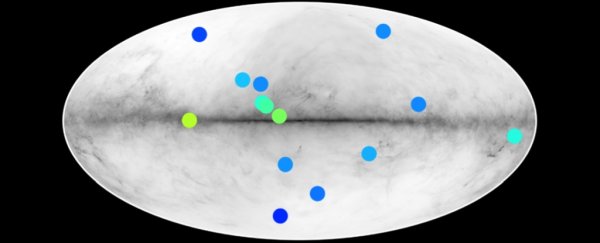In a map of the gamma-ray sky - the highest energy electromagnetic radiation streaming through our Universe - 14 objects could be hiding a big secret.
In a new analysis of the properties of that radiation, a team of astrophysicists have determined that it's consistent with what we'd expect from stars made of antimatter - hypothetical objects known as antistars.
This would be absolutely huge if true - it could help resolve one of the biggest mysteries in the Universe, that of all the missing antimatter. But there are still a few other things those 14 objects could be.
Every particle of matter that makes up the stuff we see around us - like electrons and quarks - has a counterpart with identical features, except for one thing: an opposite charge. It's thought that particles and antiparticles were produced in equal quantities at the beginning of the Universe.
When a particle and its antiparticle collide, they annihilate each other in a burst of gamma radiation, which suggests that they should still exist in equal quantities (or nothing exists at all, a cheery thought), but for some reason, only trace amounts of antimatter have been detected.
We've sort-of grown accustomed to the idea that pretty much none of the 'original' antimatter remains in the Universe. Physicists have developed models and explanations based on that assumption, it's a whole big thing.
Then along came the Alpha Magnetic Spectrometer experiment (AMS-02) aboard the International Space Station. A few years ago, it made tentative detections of antihelium - a discovery that, if validated, means enough fundamental antiparticles could have stuck around to clump into whole atoms of antimatter.
But where? According to a team of astronomers led by Simon Dupourqué at the Institut de Recherche en Astrophysique et Planétologie in France, maybe it's hiding in the form of antistars in the Milky Way.
Because antistars would behave pretty much like normal stars, they would be pretty hard to detect - unless normal matter, such as interstellar dust, accreted onto the star's surface, where it would be annihilated by the antimatter of the star.
In turn, this would produce a gamma ray excess at specific energies that, theoretically, we could detect.
We haven't detected the signature annihilation gamma-ray bump in the cosmic microwave background (that's the radiation left over from the Big Bang), or gamma-ray surveys of the Milky Way. For their study, Dupourqué and his team focused on 10 years of data from the Fermi Gamma-ray Space Telescope, closely examining the 5,787 gamma-ray sources therein to look for signs of what might be matter-antimatter annihilation.
They looked specifically for gamma-ray signatures consistent with proton-antiproton annihilation, as well as a point-like geometry in the source itself - that is, it looks like a star. Of the 5,787 sources, just 14 could be considered antistar candidates.
It's not hugely likely that these 14 objects are antistars; they could easily turn out to be known gamma-ray emitters such as pulsars or black holes. But they give us a starting point for estimating the number of antistars that could be hiding in the Milky Way.
By simulating antistar accretion processes, and assuming that antistars have similar properties to normal stars, the team derived an upper limit for this number. In the Milky Way disk, just 2.5 stars out of every million could be antistars.
Outside of the Milky Way disk, in the galactic halo, it could be a very different story. The space above and below the disk is much more empty of gas and dust, which means there's less material to accrete onto any potential antistars.
Without the accretion of normal matter, these antistars would not give off a gamma-ray excess, and would more easily evade detection in gamma-ray surveys; in fact, they could have been hiding since the beginning of the Universe.
According to the team's calculations, it's unlikely that there are any antistars within the immediate vicinity of the Solar System. This means that the source of the anti-helium would more likely be a population of these halo antistars.
You may also have noticed that 2.5 out of 1 million stars is not even close to equal proportions of antimatter and matter - so the discovery of antimatter stars would not resolve the problem of the missing antimatter.
In fact, it would probably raise the not-insignificant question of how clumps of antimatter had managed to survive when surrounded by material that would wipe it out in a flash of light.
The team's work is aimed at providing new, tighter constraints on the number of antistars that might be out there, so that future work has a better baseline to work from in trying to understand where and how antiparticles might be found in the Milky Way galaxy.
And continuing to monitor those 14 candidates will help determine whether they are antistars, or something more mundane, like a pulsar, or a black hole.
Which may be one of the only times the word "mundane" might apply to those strange, strange objects.
The research has been published in Physical Review D.
